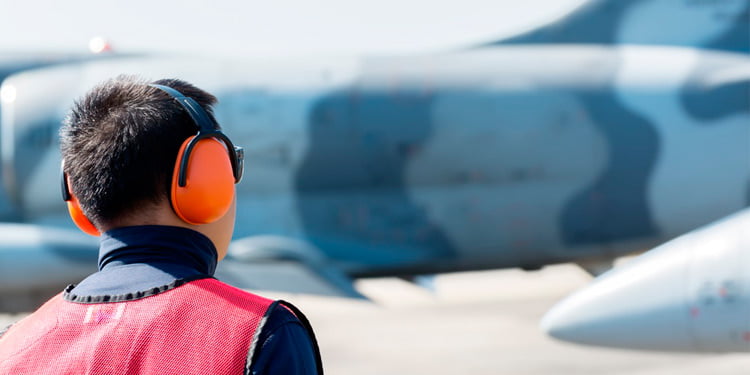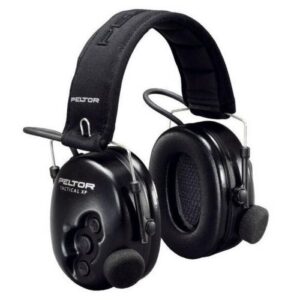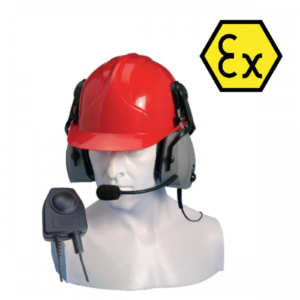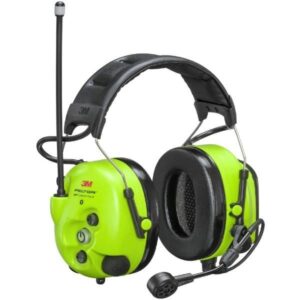With so many different ear defenders on the market it might be hard for you to decide which one to purchase. This article intends to give you hearing protection recommendations for your industry.
Broadly speaking, there are three different categories of hearing protection available; the type of protection you require will largely depend on the environment in which they will be used.
For low levels of noise, you can use a set of ear plugs; they are perfect for club and concert environments, where the noise level won’t damage your hearing immediately.
Semi-insert earplugs are simply two ear plugs that are held in place over the ears by a headband; these tend to be used in slightly louder environments than the ear plug.
The most protective product of the three is the ear defender, it protects you from extremely loud noises that can damage your hearing permanently (even after a single exposure).
Why are ear defenders necessary?
Hearing protection is designed to protect the user from dangerously high noise levels. The padding itself is made from a type of acoustic foam that absorbs the waves by increasing the air resistance in order to stop them from reaching the ear drum.
You may not realize the damage being caused, but some everyday tasks (e.g. mowing the lawn) can potentially have a catastrophic effect on you. Of course, it is not necessary to protect yourself from these types of activities but there are many more that you should approach with care.
However, some of these products do not solely protect you from excessive noise; modern technology has allowed them to house radio systems, doubling up as a two-way radios. With these devices, you don’t need to remove them in order to communicate.
Know your limits!
| Decibel Level | How long before any damage? | Source of noise | Industry Example | What is the best-suited headset? |
| 130dB | 0 minutes | Jet take off | Aviation | 3M Peltor CH3 FLX2 with microphone |
| 109dB | less than 5 minutes | Car horn | Transport | 3M Peltor Alert WS XPBluetoothh Headset |
| 106dB | 5 minutes | Speakers at high volume | Entertainment | 3M Peltor ProTac III |
| 103dB | 8 minutes | Belt sander | Manufacturing | 3M Peltor WS LiteCom Pro III |
| 97dB | 15 minutes | Motorcycle | Transport | 3M Peltor X5A Ear muffs |
| 94dB | 1 hour | Electric drill | Construction | 3M Peltor LiteCom Two-Way Radio Headset |
| 91dB | 2 hours | Lawn mower | Gardening | 3M Peltor X5A Ear muffs |
| 85dB | 8 hours | Vacuum cleaner | Home | 3M Peltor X2A Ear muffs |
What are SNR and dB?
The SNR is a single-number rating system that you can use to measure the level of noise attenuation of each product. When you know the SNR of different products you can then compare them and decide which product best suits your needs.
In order to work out the acoustic pressure on your ears you need to subtract the SNR from the noise level measurement.
For example, the outside noise reading is 80dB
The SNR value of your hearing protection is 25,
80 (dB) – 25 (SNR) =55
Therefore, the new dB level is 55
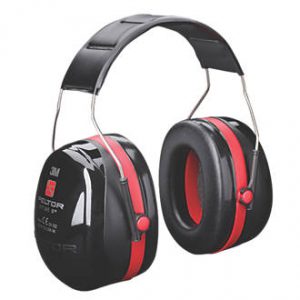
Types of ear defender
Standard – Large variety of products available on the market in a range of shapes and sizes.
Electronic – More advanced than the standard ear defender, these pick up low levels of sound from the outside environment and relay them to you at an audible level.
With radio – These have a built-in two-way radio system that allows the user to communicate with colleagues.
Choosing the right ones for you
With the great variety of ear defenders on the market today, it can prove rather difficult to find the perfect product to suit your needs. We consider the level of noise exposure in your working environment and the comfort of the product itself as being of vital importance when making this choice.
Another factor to consider is to what extent you wish to reduce the noise. At times staff prefers to use earmuffs as they provide a more suitable level of no-frills protection and ear plugs are inconvenient to constantly remove and put in. Additionally, if your job requires constant communication, you may require a product that includes a two-way radio system.
Our recommended ear defenders:
3M Peltor CH3 FLX2 with microphone
- Noise-cancelling beam mounted with PTT
- Passive communication
- High attenuation (31dB)
- Built-in noise-canceling microphone
3M Peltor Tactical XP Standard
- Protects you against loud sounds, amplifies soft sounds, and attenuates sudden loud noises
- High attenuating hearing protection – above 85dB
- Audio input jack for external radio
- Battery life: 1000 hours
ATEX Ear Defender for Entel HT ATEX (Hard Hat)
- ATEX-approved intrinsically safe
- SNR: 30dB
- VOX hands-free and PTT button
- High-quality noise-canceling boom microphone
Entel CHP750D Ear Defender with Mic
- Heavy duty double ear cup ear defender
- SNR: 30dB
- VOX hands-free and PTT button
- High-quality noise-canceling boom microphone
3M Peltor LiteCom Neckband version
- Noise-canceling microphone and VOX
- High attenuating ear defender – SNR: 32dB
- In-built microphone for mobile and radio communications
- Spiral cord for connection to Peltor adapter that enables PTT (push to talk)
M Peltor WS LiteCom Pro III
- Hearing protection with integrated analog and digital radio
- Waterproof microphone and VOX function
- Eye-catching and sound-regulated for protection
- With Bluetooth connection
- Isolation – SNR: 33 dB
The necessity for protection is obvious with certain jobs (e.g. at airports, working with heavy machinery); health and safety regulations will require you to wear at least some form of protective headset whilst you work.
If you look at the table there are many jobs above the 85dB mark; at this point, noise exposure becomes particularly harmful. If working in environments with high noise levels, we strongly recommend investing in sound protective equipment to avoid lasting damage.
